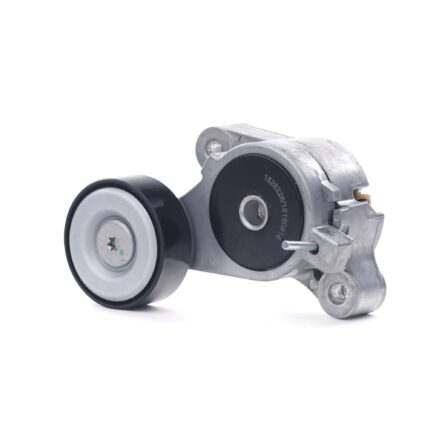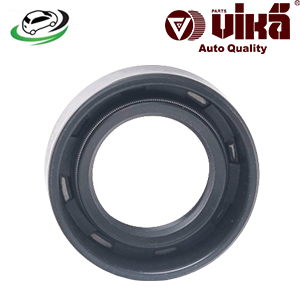Get Radial Shaft Seal18X30X6.4/8 VW Cabrio III/ Golf II/ Golf III/ Jetta II/ Jetta III/ Scirocco II 020301227D
A radial shaft seal, commonly referred to as a radial seal or oil seal, is a crucial component used in various mechanical systems to prevent the leakage of fluids and protect against contaminants. These seals are widely used in automotive engines, transmissions, pumps, and other machinery where rotating shafts and housing meet. Understanding the design, function, benefits, common issues, and maintenance of radial shaft seals is essential for ensuring the longevity and efficiency of machinery.
Function and Importance
- Leak Prevention: The primary function of a radial shaft seal is to prevent the leakage of fluids such as oil, coolant, or grease from the housing where a rotating shaft passes through. This is critical for maintaining fluid levels and ensuring the proper functioning of machinery.
- Contaminant Protection: Radial shaft seals protect the internal components of machinery from external contaminants like dust, dirt, and moisture. By sealing the gap between the shaft and housing, these seals prevent contaminants from entering and causing damage.
- Lubrication Maintenance: In machinery where lubrication is necessary, radial shaft seals help retain the lubricant within the system. This ensures that moving parts remain properly lubricated, reducing friction and wear.
- System Integrity: By preventing fluid leakage and contamination, radial shaft seals help maintain the overall integrity and performance of the machinery. They contribute to the reliability and efficiency of the system, reducing the risk of failures and costly repairs.
Design and Construction
- Materials:
- Rubber: Most radial shaft seals are made from elastomers like nitrile rubber (NBR), fluorocarbon (FKM), or silicone. These materials are chosen for their flexibility, resistance to wear, and ability to withstand a wide range of temperatures and chemicals.
- Metal: Some seals incorporate metal components, such as a metal casing or spring, to enhance strength and support. The metal parts provide structural integrity and improve the seal’s performance.
- Design:
- Seal Lip: The seal features a flexible lip that makes contact with the rotating shaft. The lip creates a tight seal, preventing fluid leakage and protecting against contaminants. The lip’s design can vary depending on the application, such as single-lip or double-lip configurations.
- Spring: Many radial shaft seals include a spring, often made of stainless steel, that applies constant pressure to the seal lip. This ensures a consistent seal against the shaft and compensates for wear over time.
- Casing: The seal is housed in a rigid casing that fits into the housing bore. The casing provides support and ensures proper alignment of the seal.
- Types:
- Single-Lip Seals: These seals have one sealing lip and are commonly used in applications where only one side needs to be protected from leakage and contamination.
- Double-Lip Seals: Double-lip seals feature two sealing lips and are used in applications where both sides of the shaft need protection. They provide enhanced sealing capability and improved performance in challenging environments.
- Metal-Bonded Seals: These seals have a metal outer casing bonded to the elastomeric sealing lip. They offer additional strength and durability for high-pressure or high-temperature applications.
Benefits
- Effective Leak Prevention: Radial shaft seals are highly effective at preventing the leakage of fluids, helping to maintain fluid levels and prevent environmental contamination.
- Enhanced Contaminant Protection: By keeping contaminants out, radial shaft seals help protect sensitive internal components from damage, reducing maintenance needs and extending the life of the machinery.
- Improved Lubrication: Seals help retain lubrication within the system, ensuring that moving parts remain properly lubricated and reducing friction and wear.
- Versatility: Radial shaft seals are available in various sizes and materials, making them suitable for a wide range of applications and operating conditions.
- Cost-Effective: Properly functioning radial shaft seals reduce the need for frequent repairs and replacements, making them a cost-effective solution for maintaining machinery.
Common Issues
- Wear and Tear:
- Seal Lip Wear: Over time, the seal lip can wear out due to friction, heat, and exposure to contaminants. This can lead to reduced sealing effectiveness and potential leakage.
- Spring Fatigue: The spring that maintains pressure on the seal lip can lose its tension or become damaged, compromising the seal’s performance.
- Contamination:
- Debris Ingress: If the seal is damaged or improperly installed, debris can enter the system, causing abrasion and wear on the shaft and seal.
- Fluid Contamination: Contaminants in the fluid, such as dirt or water, can degrade the seal material and lead to premature failure.
- Installation Issues:
- Misalignment: Improper alignment of the seal during installation can cause uneven wear or damage. This can result in leaks and reduced sealing performance.
- Improper Fit: Using a seal that does not match the specifications of the shaft or housing can lead to poor sealing and leakage.
- Temperature and Chemical Exposure:
- Heat Damage: Excessive heat can cause the seal material to degrade or become brittle, leading to leakage and failure.
- Chemical Compatibility: Exposure to incompatible chemicals or fluids can cause the seal material to swell, shrink, or break down.
Maintenance and Inspection
- Regular Inspections:
- Visual Check: Periodically inspect radial shaft seals for signs of wear, damage, or leakage. Look for any visible cracks, splits, or fluid stains around the seal.
- Shaft Condition: Check the condition of the shaft for signs of wear or scoring, as these can affect the seal’s performance and lead to leakage.
- Leak Detection:
- Fluid Levels: Monitor fluid levels in the system to detect any drops that may indicate a seal leak. Regularly check for any signs of leakage around the seal.
- Pressure Testing: Perform pressure tests on the system to identify any leaks or weaknesses in the seal and surrounding components.
- Replacement:
- Timely Replacement: Replace radial shaft seals if they show signs of wear, damage, or leakage. Addressing these issues promptly can prevent further damage to the machinery and maintain optimal performance.
- Quality Parts: Use high-quality replacement seals that match the specifications of your machinery to ensure proper fit and performance.
- Professional Assistance:
- Mechanic’s Inspection: If you are unsure about the condition of the seal or experience issues with leakage or performance, seek professional assistance. A mechanic can perform a thorough inspection and recommend any necessary repairs or replacements.
Replacement Process
- Locate the Seal:
- Find the Seal: Identify the radial shaft seal, which is typically located where the rotating shaft passes through the housing. It may be part of a larger assembly or integrated into the housing.
- Remove the Old Seal:
- Disassemble Components: Carefully disassemble any components or housing that obstruct access to the seal. Be cautious of fluid spills and follow safety procedures.
- Remove the Seal: Use appropriate tools to remove the old seal, taking care not to damage the shaft or housing. If the seal is press-fitted, use a seal puller or similar tool.
- Install the New Seal:
- Prepare the Seal: Ensure that the new seal is compatible with the shaft and housing. Inspect the seal for any damage or defects before installation.
- Position the Seal: Place the new seal into the housing, ensuring proper alignment and fit. Use appropriate tools to press the seal into place, being careful not to damage it.
- Verify Operation:
- Reassemble Components: Reassemble any components or housing that were disassembled for access to the seal. Ensure that all connections are secure and properly sealed.
- Check for Leaks: Start the machinery and monitor the seal area for any signs of leakage. Ensure that the seal is functioning properly and that the system maintains fluid levels and performance.
Follow us on Facebook for more parts



